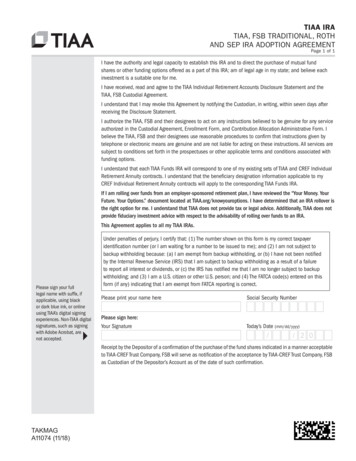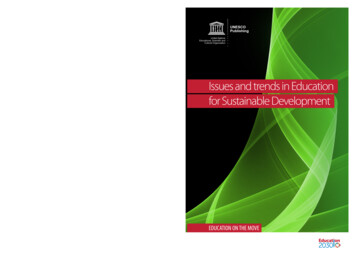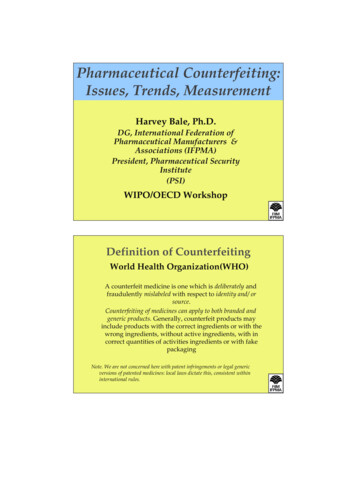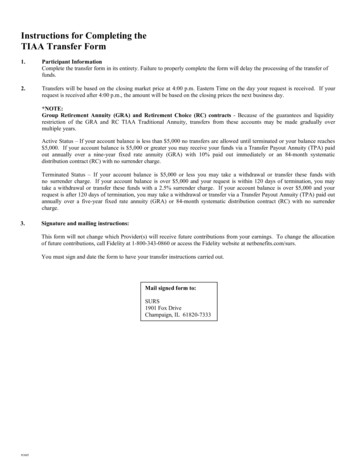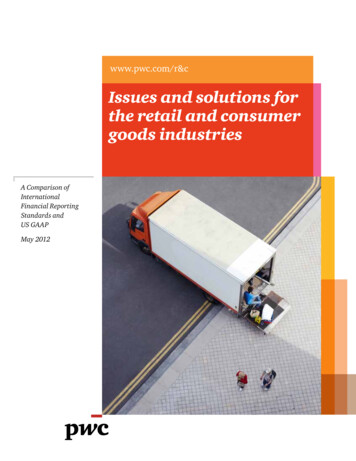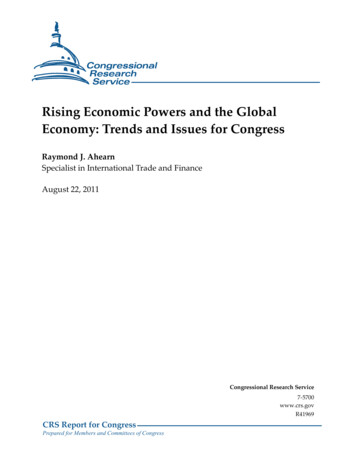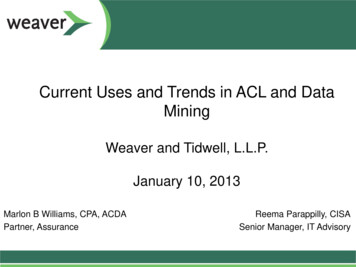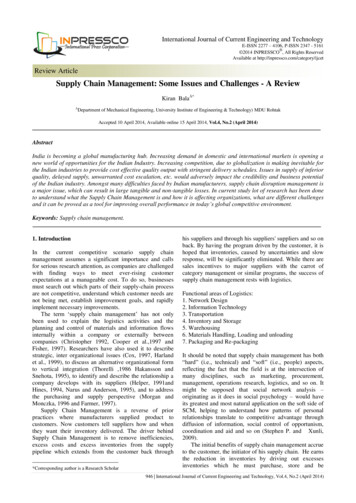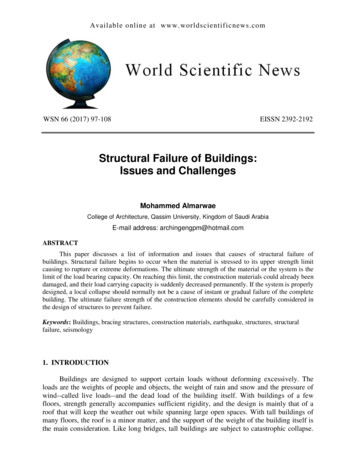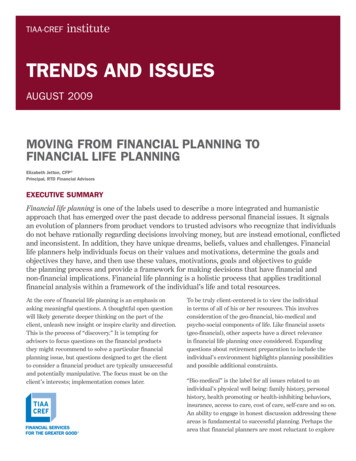
Transcription
TRENDS AND ISSUESAUGUST 2009MOVING FROM FINANCIAL PLANNING TOFINANCIAL LIFE PLANNINGElizabeth Jetton, CFP Principal, RTD Financial AdvisorsEXECUTIVE SUMMARYFinancial life planning is one of the labels used to describe a more integrated and humanisticapproach that has emerged over the past decade to address personal financial issues. It signalsan evolution of planners from product vendors to trusted advisors who recognize that individualsdo not behave rationally regarding decisions involving money, but are instead emotional, conflictedand inconsistent. In addition, they have unique dreams, beliefs, values and challenges. Financiallife planners help individuals focus on their values and motivations, determine the goals andobjectives they have, and then use these values, motivations, goals and objectives to guidethe planning process and provide a framework for making decisions that have financial andnon-financial implications. Financial life planning is a holistic process that applies traditionalfinancial analysis within a framework of the individual’s life and total resources.At the core of financial life planning is an emphasis onasking meaningful questions. A thoughtful open questionwill likely generate deeper thinking on the part of theclient, unleash new insight or inspire clarity and direction.This is the process of “discovery.” It is tempting foradvisors to focus questions on the financial productsthey might recommend to solve a particular financialplanning issue, but questions designed to get the clientto consider a financial product are typically unsuccessfuland potentially manipulative. The focus must be on theclient’s interests; implementation comes later.To be truly client-centered is to view the individualin terms of all of his or her resources. This involvesconsideration of the geo-financial, bio-medical andpsycho-social components of life. Like financial assets(geo-financial), other aspects have a direct relevancein financial life planning once considered. Expandingquestions about retirement preparation to include theindividual’s environment highlights planning possibilitiesand possible additional constraints.“Bio-medical” is the label for all issues related to anindividual’s physical well being: family history, personalhistory, health promoting or health-inhibiting behaviors,insurance, access to care, cost of care, self-care and so on.An ability to engage in honest discussion addressing theseareas is fundamental to successful planning. Perhaps thearea that financial planners are most reluctant to explore
with clients is the psycho-social. But who else is better positioned to help the client consider the relationship of his orher emotional, psychological and social well-being in relation to financial well-being? Often it is an issue arising fromone of these factors that encourages someone to retire too soon or to avoid it unnecessarily. Financial life planning isnot concerned with exploring mental or emotional dysfunction, but it is concerned with exploring beliefs that mayunconsciously drive decisions.In the wake of the economic meltdown, we are seeing people employ all of their resources in order to manage. Theyare drawing on their creativity and their community connections. They are becoming more conscious of spendinghabits. They are seeking more guidance and support. They are questioning what it means to plan for the future insuch uncertain times. In the process, individuals are discovering that they are more resilient and resourceful thanthey realized and that the ability to be resilient and flexible is critical to thriving and realizing a life plan. Nurturingand tracking such qualities is within the financial life planner’s realm of focus. Helping clients find ways to moveforward, to plan, to make decisions and to make choices that support their ability to maintain a quality of life atevery stage of life is the goal.INTRODUCTIONThere is nothing like a global financial crisis to force one to “take stock.” Workers, retireesand retiree-want-to-be’s are questioning their decisions, their future and how to thrive or getby right now. The recession has also led to a state of concern among financial advisors. Thefinancial planning profession was just emerging as the ’73 recession was winding down.Advisors and clients have overall enjoyed growth of asset values and abundance ever sincewith only the occasional downturn. Our age of innocence is ending. We are, alas, growing up.Growing up requires some letting go, some pain and some hard-won wisdom. The good newsis that financial planners have always been an innovative bunch, learning from mistakes,listening to clients and wondering about what the future holds. We have as a community ofprofessionals, never been satisfied. The desire to make a meaningful difference in our clients’lives is genuine. The search for the right approach, best processes, most prudent and effectiveinvestment philosophy and most sophisticated analytical tools is never ending. The soulsearching has reached critical proportions today in the face of economic uncertainty.Over the last ten years a shift has been occurring that has become more significant in light of the currentenvironment. Financial life planning is one of the labels used to describe a more integrated and humanisticapproach to addressing personal financial issues, in contrast to a more product-driven, transaction-based andnumbers-driven system of client care. It has evolved as the world of personal finance has increased in complexity.Planning professionals in search of sustainable results have learned from their clients and from behavioral researchin fields ranging from economics and finance to the social sciences and the arts. It represents the integration of the“art, heart and science” of financial planning. By any name it is impacting the practice of planning and the clientexperience and results.Over the years the financial planner has evolved from product vendor to trusted advisor.1 The progression fromproduct-centered to advice-driven is grounded in the genuine sense of responsibility to the client. It continues toevolve. The breadth and depth of financial planning is expanding and in the process a new model is emerging thatmay define financial planning going forward. At the core is the recognition that the client is NOT the money; it is,rather, the person. Until recently economics has sought to portray behavior around money as rational. Its models1 See Maister, David H., Charles H. Green and Robert M. Galford. The Trusted Advisor. Free Press (2000.)TRENDS AND ISSUES AUGUST 2009 2
have been built on this premise. The financial planner in practice quickly realizes that individuals do not in factbehave rationally around questions and decisions involving money, but are instead, emotional, conflicted andinconsistent. As a result humans may act in ways that are against their best interest. Humans are not only emotional;they have unique dreams, beliefs, values and challenges. Each individual defines prosperity for himself, consciouslyor more often, unconsciously. That is the domain of the financial life planner—the work of helping individuals tothrive where money and life intersect.Financial planner and 2003 recipient of the P. Kemp Fain Jr. Award2, Dick Wagner, has said that money is the mostpowerful secular force on the planet and that the financial life planner’s role is to help individuals cope with moneyin the midst of uncertainty. In that case we can only assume that financial planning must concern itself with allaspects of an individual’s life: Family and relationshipsValuesNotions of personal fulfillmentHistory, beliefs and attitudesEmotional well-beingWork/life satisfactionPurpose and meaningHealth and physical well-beingEnvironmentCultural and community lifeLegacy and stewardship intentDefinition of freedomRisk definition and toleranceThe list is surely not exhaustive but one can see that a thriving life has to do with more than money and that moneyis often a connector between the self and fulfillment in these areas. What we understand from over 30 years inpractice is that helping people cope with uncertainty, make good financial decisions and live a thriving life requiresboth broad technical knowledge and deep communication skills. Both are necessary in order to tend both the interiorand exterior aspects of an individual’s financial life.The forward-thinking, client-centered financial planner who wishes to embrace the full range of what planning hasto offer, will focus on being a bridge between the clients life and their financial resources, applying the technical tools,processes and knowledge in the context of the more qualitative, human-connection skills.Those who practice comprehensive financial planning are less likely to lose clients and more likely to add new clientsduring times of crisis. The reason is simple: the financial planner is bringing greater value and offering a broaderarray of service and advice, a currency that holds its value in good and bad markets. The financial planner has anedge by occupying a unique place in the client’s mind, that of trusted advisor as well as investment manager.2The P. Kemp Fain, Jr. Award recognizes an individual who has made outstanding contributions to the financial planning profession in theareas of service to society, academia, government and professional activities. Recipients must also exemplify FPA’s core values of integrity,competence, relationships and stewardship. P. Kemp Fain, Jr., formed the first International Association for Financial Planning (IAFP)chapter in the nation in 1971 and served as its first president.TRENDS AND ISSUES AUGUST 2009 3
ADDRESSING CLIENT WANTS AND NEEDSResearch supports the anecdotal observation that clients place value on being heard and understood.3 Clients valuethe relationship with the advisor in addition to competence. They want an advisor who inspires confidence. Theywant to be viewed as more than the sum of their investment assets. They need help with complex issues, not all ofwhich can be solved with a financial product. The advisor may focus on what the clients needs, but the clients arefocused on what they want! A successful engagement bridges the two. From the perspective of advisors, what clientsneed is to heed their sound advice, invest a certain way or purchase a certain product that solves a concern the clientmay not even have expressed!At its core financial planning is about helping clients make smart decisions and to cope and thrive in a world ofuncertainty. Individuals need confidence to make decisions and to understand the consequences of their decisions.They seek a guide to help them address all of the life-impacting financial decisions they will make. Clients want atrusted advisor. Trust develops over time through competency and authentic communication. Trust inspires action.As a result, in the financial life planning engagement, the ability to know the client more deeply is key to success.This is often challenging to planners who may tend to separate their technical knowledge from building a connectionwith the client. Clients are not served when advisors “spew out their technical knowledge”. Successful financial lifeplanning is a collaborative process.There is no short cut to building a relationship or trust. It requires an investment of time. Clients must see a trend ofalignment between what we say we will deliver and what we actually provide. That is why we talk about financialplanning as a process and not a “transaction” or “event”. The results are literally compounded and embedded in therelationship itself.Those advisors who have had a process in place for delivering advice and ongoing care have clients who feelwell-tended and loyal in this time of crisis. There is a foundation of trust and of being valuable and even vital tothe well-being and sense of clarity and freedom for the client.WHAT IS FINANCIAL LIFE PLANNING?Anderson and Sharpe define financial life planning as “A process conducted To help financial planning clients(1) focus on the true values and motivations in their lives, (2) determine the goals and objectives they have as theysee their lives develop and (3) use these values, motivations, goals and objectives to guide the planning process andprovide a framework for making choices and decisions in life that have financial and non-financial implications orconsequences A collaborative, client-centered approach to communication that integrates a client's values-basedlife goals with their financial goals."4Imagine that you are sitting down to begin a jigsaw puzzle. Once you have dumped the pieces onto the table, whatdo you do next? Most folks would place the edge pieces, or sort the pieces by color. For our clients, the pieces arethe stuff of plans: income, debt, taxes, savings, investments, etc. The picture on the box is the life they want to create:the life today and the life tomorrow. Every time we meet for the renewal meeting, we must update the picture on thebox top as surely as we update our records and understanding of the pieces. Think of your own life and how quicklythings change: your dreams, your family issues, your job, your fears and what overwhelms you, your behavior. Weare unique in our profession in that we have the capacity to impact our clients’ ability to thrive both today in thehere and now, and far into the future.34Anderson, Carol, and Deanna L. Sharpe. “Research: Communication Issues in Life Planning.” Journal of Financial Planning (June 2008.)Ibid.TRENDS AND ISSUES AUGUST 2009 4
“Not everything that counts can be counted, and not everything that can be counted, counts.”–Albert EinsteinEinstein didn’t know that he was offering the essence of financial life planning when he spoke those words. Financiallife planning is focused on what can be counted in our clients lives—their money and finances—as well as those thingswe cannot count—their aspirations, fears, health, concerns, challenges, will, resilience, coping skills, etc. As DaveYeske, former FPA president, has said, “Planning is in the space between the subsets.”What we are getting at in these statements is that the outcome of planning goes beyond exterior recommendations.There is an interior aspect that contributes to the experience of thriving and to the success of the plan.In this challenging time we are seeing the consequences of an overemphasis on investment returns. Most of ourclients and advisors have grown up in a world of surging economic growth reflected in the stock market, with theoccasional bubble burst or short-lived downturn or recession. Suddenly the truth of uncertainty has struck.Quite simply every individual is struggling with a fundamental tension: the tension that exists between what I needand want today versus what I will need and want in the future. Traditional financial planning has placed most of itsfocus on the future, but the future is created through every decision made today. The ability to guide individuals’financial decisions now, is key to success and to sustainability. We know that knowing what to do is not enough. Wemust meet our client where he or she is, to find a way to inspire to action, to engage in a rich dialogue that leads toa partnership of trust as the basis for successful decision-making.It helps to be reminded that in the holistic planning model, planners help people control the things they CANcontrol so that the things they CANNOT control do less harm to their financial well-being and the achievement oftheir aspirations. None of us has the ability to predict the market or time the market. We cannot control the tax codeor the future value of our homes or the cost of health care. We can control how much we save, how much we spend,how clear we are on what matters to us, our priorities. Also, we can control our work to a degree, our values andhow we live them. We can take measures to protect our health and our family. We can build our knowledge, ourrelationships and our resiliency. We can devise a plan and implement it so that we have done what we can tominimize the consequences of negative surprises. We can build reserves that allow us to take advantage ofopportunities. We can communicate with our spouse so that we are in alignment. When all is said and done,planners have a responsibility to take this broader definition of our role very seriously.THE PROCESS OF FINANCIAL LIFE PLANNINGAt the core of financial life planning is the emphasis on asking meaningful questions. Great questions help us paintthat picture on the puzzle box top. A thoughtful open question may generate deeper thinking on the part of the client,unleash new insight or inspire clarity and direction. Good questions lead to critical learning on the part of the advisorand the client. We call this process “discovery.”The ability to ask truly opening questions is difficult because it is so easy to embed our own assumptions and beliefsinto our questions. For instance, the question, “When do you want to retire?” makes an assumption that the individualdoes in fact, want to retire. Perhaps a better question in the framing of financial life planning would be, “What do youwant to do during your 60s, 70s and 80s? Note the difference between the question “How much money do you want tospend in retirement?” versus “Describe a thriving life in retirement.” Perhaps both questions are warranted, but oneassumes that one’s financial resources are the key to a happy quality of life. The other question opens the possibilitiesto find resources aside from financial ones, to address goals and aspirations. Good questions lead to critical thinking,and critical thinking leads to better, more thoughtful decisions.TRENDS AND ISSUES AUGUST 2009 5
Consider how advisors often approach the conversation about the need for life insurance. It is often approachedthrough a capital needs analysis and a discussion which leaves the client cold and often suspicious. Through thedeeper discovery process a client will often express that nothing would cause regret more than leaving his familywithout financial security should the unthinkable happen. Connecting the client’s values and personal prioritieswith the conversation about income replacement in the event of unexpected death strikes a personal chord thatinspires action rather than resistance.It is tempting for advisors to focus questions on the financial products they might recommend to solve a particularfinancial planning issue, such as life insurance to address income replacement in the event of death or an annuityto provide a guaranteed income regardless of the length of one’s life. Old habits die hard, but questions that aredesigned to get the client to consider a financial product are usually not successful and are potentially manipulative.If financial planning is to be recognized as a professional activity, the focus must be on the client’s interests.Implementation comes later.An open inquiry into what is most important to a client in retirement will almost certainly lead the client to expressconcerns about maintaining lifestyle and income, regardless of lifespan and health issues. One of the best questionsthe financial life planner often asks is simply, “Tell me more about that,” or “is there anything else?” Listening is nota hurry-up-so-I-can-close process. It is an expression of care, attention, genuine curiosity and alignment that requiresa slower place and a willingness to let go of dominating the conversation, leading to a particular outcome and rushingto solutions.The process of financial life planning applies traditional financial analysis (addressing risk management issues,income needs, asset allocation, etc.) within a framework of the individual’s life and total resources.The most skilled practitioners of financial life planning have developed their technical skills, communication skillsand presentation skills to create a seamless experience for the cl
MOVING FROM FINANCIAL PLANNING TO FINANCIAL LIFE PLANNING Elizabeth Jetton, CFP Principal, RTD Financial Advisors EXECUTIVE SUMMARY Financial life planningis one of the labels used to describe a more integrated and humanistic approach that has emerged over the pas
